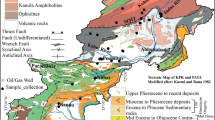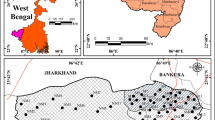Abstract
The paper presents results of research to determine the health risk of potentially toxic elements (PTEs) in soils of gold mining area in Ilesha, Southwestern Nigeria. Eighteen top soil samples were collected and analysed for PTEs using ICPMS. The pollution level in soils were assessed using pollution load index (PLI) and potential ecological risk index (PERI). The human health risk was assessed using hazard index (HI), non-carcinogenic risk index and carcinogenic risk index. All the PTEs were higher than crustal average values except Fe and follow the order Mn > Ba > Cr > Zn > Cu > Ni > Pb > Co >Fe > As > Cd. The soil samples can be classified as unpolluted to moderately polluted (0.18-1.23) and low risk (15.28-94.24) based on PLI and PERI respectively. The values of hazard Index (HI) calculated for child and adult population for all the pathways were <1 and pose no obvious non carcinogenic risk to the population except for ingestion pathway where 33% of the samples showed value >1 in child population. As, Co, Cd and Pb constituted high cancer risk in the study area with child at higher risk than adult. The Total Cancer Risk (TCR) in the study area based on all the pathways ranges between 0.19 -3.86 and 0.18-3.58 for child and adult respectively and the ingestion route seems to be the major contributor to excess lifetime cancer risk followed by the dermal pathway.
Similar content being viewed by others
References
Ajayi and Adegoke-Anthony, C.W. (1988) Groundwater prospects in the basement complex rocks of Southwestern Nigeria. Jour. African Earth Sci., v.7(l), pp.227–235.
Bosso, S.T and Enzweiler, J. (2008) Bio accessible lead in soils, slag, and mine wastes from an aband oned mining district in Brazil. Environ. Geochem. Health. v.30, pp.219–229.
Carla, C., Eduardo, F., Paula, F.Á and João, P.T. (2014) Identifying Sources and Assessing Potential Risk of Exposure to Heavy Metals and Hazardous Materials in Mining Areas: The Case Study of Panasqueira Mine (Central Portugal) as an Example. Geosciences, v.4, pp.240–268. DOI: 10.3390/geosciences4040240.
Chen, Y.H, Xie, W.B, Wu, Y.J, Wang, Z.H. (2001) Utilization of Mineral Resources Containing Thallium and Thallium Pollution in China. J. Shenzhen Univ. (Sci. Eng.) (in Chinese), v.18(1). 57p.
Department of Environmental Affairs (2010) The Framework for the Management of Contaminated Land, South Africa. 2010. Available online: http://sawic.environment.gov.za/documents/562.pdf (accessed on 5 February 2016).
Edna, S.D., Renato, A.T, Hercilia, S.C., Fabio, J.O., Leonidas, C.A., Kelson, D.F and Antonio, R.F. (2017) Assessment of risk to human health from simultaneous exposure to multiple contaminants in an artisanal gold mine in Serra Pelada, Pera, Brazil. Sci. Total Environ., v.576, pp.683–695.
Elueze, A.A. (1977) Geological and geochemical studies in the Ilesha schist belt in relation to gold mineralization, M.Phil. Thesis (Unpublished), Department of Geology and Mineral Sci., University of Ibadan.
Hakanson, L. (1980) Ecological Risk Index for Aquatic Pollution Control, a sedimentological Approach. Water Res., v.14 (8), pp.975–1001.
Hu, Z., Haneklaus, S., Sparovek, G and Schneg, E (2006) Rare earth elements (REEs) in soils. Common. Soil. Sci. Plan., v.37, pp.1381–1420.
Ikenna, T.O., Jeremy, P., Richards, R.S., Theresa, G and Tara, M. (2015) Artisanal and small scale mining in Nigeria. Experiences from Niger, Nasarawa and Plateau states. The Extractive Industries and Society, v.2, pp.694–703.
Ji, K., Kim, J., Lee, M, Park, S., Kwon, H., Cheory, H., Jang, J., Kim, D., Yu, S., Kim, Y., Lee, K., Yang, W., Pack, D., Hong, R and Choi, k. (2013) Assessment of exposure to heavy metals and health risks among residents near aband oned metals mines in Goseong, Korea, Environ. Pollut., v.178, pp.322–328. DOI: 10.1016 /J. envpol. 2013. 03.031.
Kayode, J.S. (2009) Vertical component of the ground magnetic study of Ijebu-Ijesa, Southwestern Nigeria. A paper presented at the international association of Seismologist and physics of the earth interior (IASPEI) 2009 conference at Cape Town, South Africa. Jan 10th-16th.
Khan, S., Cao, Q., Zheng, Y.M., Huang, Y.Z., Zhu, Y.G. (2008) Health risks of heavy metals in contaminated soils and food crops irrigated with wastewater in Beijing, China. Environ. Pollut., v.152, pp.686–692.
Li, Z., Ma, Z., Jan Van Der Kuijp, T., Yuan, Z., Huang, L. (2014) A review of soil heavy metal pollution from mines in China: pollution and health risk assessment. Sci. Total Environ., v.468-469, pp.843–853.
Lu, X.W., Zhang, X.L., Li, L.Y., Chen, H., (2014) Assessment of metals pollution and health risk in dust from nursery schools in Xi’an, China. Environ. Res., v.128, pp.27–34.
Luo, X.S., Yu, S., Zhu, Y.G., Li, X.D., (2012). Trace metal contamination in urban soils of China. Sci. Total Environ., v.17, pp.421–422.
Moreno-Jimenez, E., Pe~nalosa, J.M., Manzano, R., Carpena-Ruiz, R.O., Gamarra, R., Esteban, E. (2009). Heavy metals distribution in soils surrounding an aband oned mine in NW Madrid (Spain) and their transference to wild flora. Jour. Hazard Mater., v.162, pp.854–859.
Mudgal, V., Madaan, N., Mudgal, A., Singh, R.B., Mishra, S. (2010). Effect of toxic metals on human health. Open Nutraceuticals Jour., v.3, pp.94–99.
Nemerow, N.L. (1985) Stream, Lake, Estuary and Ocean Pollution. Van Nostrand Reinhold Publishing Co., New York
NPC (2006) Report of Nigeria’s National Population Commission on the 2006 Census Population and Development Review, v.33(1), pp.206–210
Obiora, S.C., Chukwu, A., Toteu, S.F., & Davies, T.C. (2016). Assessment of heavy metal contamination in soils around lead (Pb) zinc (Zn) mining areas in Enyigba, Southeastern Nigeria. Jour. Geol. Soc. India, v.87, pp.453–462.
Reis, A.C, As Minas, D.P., Bol. Minas. (1971). 8, 3–34. (In Portuguese) Government of South Africa. Regulation Gazette: No. 8454, v.490, No. 28755; Government of South Africa: Pretoria, South Africa, 2006.
Tomlinson, D.C., Wilson, J.G., Harris, C.R. and Jeffrey, D.W. (1980). Problems in Assessment of Heavy Metals in the Estuaries and the Formation of Pollution Index. Helgoland Mar. Res., v.33, pp.566–575.
U.S. Environmental Protection Agency (1989) Risk Assessment Guidance for Superfund: Human Health Evaluation Manual [part A]: Interim Final. Washington, DC, USA:
USEPA (2010). Integrated Risk Information System. (IRIS). United States Environmental Protection. Available online: http://www.epa.gov/iris/index.html (accessed on 4 October 2011).
U.S. Environmental Protection Agency (USEPA) (2001) Risk Assessment Guidance for Superfund: Volume III–Part A, Process for Conducting Probabilistic Risk Assessment; EPA 540-R-02-002; U.S. Environmental Protection Agency: Washington, DC, USA U.S.
Environmental Protection Agency (2004) Risk Assessment Guidance for Superfund Volume I: Human Health Evaluation Manual (Part E, Supplemental Guidance for Dermal Risk Assessment); USEPA: Washington, DC,USA.
U.S. Environmental Protection Agency. (2007). Framework for Determining a Mutagenic Mode of Action for Carcinogenicity: Review Draft. 2007. Available online: http://www.epa.gov/osa/mmoaframework/pdfs/MMOAERD-FINAL-83007.pdf (accessed on 3 October 2015).
United Nations Environment Programme (2008) The UNEP 2008 Annual Report. www.unep.org.
Wu, L., Zhou, Y.P., Zhong, H.J. (2003) A case control study on the risk factors of leukemia in mining areas of rare earth in south Jiangxi, Chm. Jour. Epidemiol., v.24. pp.879–882.
Xiao, Q., Zong, Y and Lu, S. (2015) Assessment of heavy metal pollution and human health risk in urban soils of steel industrial city (Anshan), Liaoning, Northeast China. Ecotoxiological and Envtal safety, pp.377–385.
Zhao, L., Xu, Y., Hou, H., Shangguan, Y., Li, F. (2014) Source identification and health risk assessment of metals in urban soils around the Tanggu chemical industrial district, Tianjin, China. Sci. Total Environ. 468. 654–662. DOI:/10.1016/j. Sciotenenv.2013.08.094.
Zhang, L. P., Ye, X., Feng, H., et al., (2007). Heavy Metal Contamination in Western Xiamen Bay Sediments and Its Vicinity, China. Marine Pollution Bull., no.5.
Li, Z., Ma, Z., Jan Van Der Kuijp, T., Yuan, Z., Huang, L. (2014) A review of soil heavymetal pollution from mines in China: pollution and health risk assessment. Sci. Total Environ., v.468-469, pp.843–853.
Author information
Authors and Affiliations
Corresponding author
Rights and permissions
About this article
Cite this article
Odukoya, A.M., Olobaniyi, S.B. & Oluseyi, T.O. Assessment of Potentially Toxic Elements Pollution and Human Health Risk in Soil of Ilesha Gold Mining Site, Southwest Nigeria. J Geol Soc India 91, 743–748 (2018). https://doi.org/10.1007/s12594-018-0933-7
Received:
Accepted:
Published:
Issue Date:
DOI: https://doi.org/10.1007/s12594-018-0933-7




